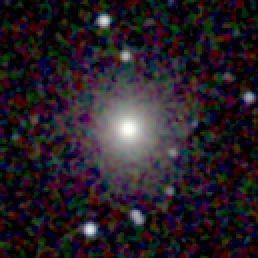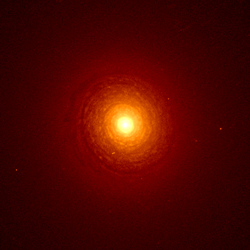Astronomy:NGC 759
| NGC 759 | |
|---|---|
 2MASS image of NGC 759. | |
| Observation data (J2000 epoch) | |
| Constellation | Andromeda |
| Right ascension | 01h 57m 50.3s[1] |
| Declination | 36° 20′ 35″[1] |
| Redshift | 0.015567[1] |
| Helio radial velocity | 4667 km/s[1] |
| Distance | 230 Mly (70.4 Mpc)[1] |
| Group or cluster | Abell 262 |
| Apparent magnitude (V) | 13.3[1] |
| Characteristics | |
| Type | E[1] |
| Size | ~110,000 ly (33 kpc) (estimated)[1] |
| Apparent size (V) | 1.6 × 1.4[1] |
| Other designations | |
| MCG 6-5-67, PGC 7397, UGC 1440[1] | |
NGC 759 is an elliptical galaxy located 230 million light-years away[2] in the constellation Andromeda. NGC 759 was discovered by astronomer by Heinrich d'Arrest on September 17, 1865.[3] It is a member of Abell 262.[4][5][6][7][8]
Despite being classified as a radio galaxy,[9][10][11][12][13] the radio emission in NGC 759 could be due to star formation rather than an active galactic nucleus.[12][13]
Dust disk
The central region of NGC 759 harbors a face-on dust disk with tightly wound spiral structure. The disk has a diameter of 11,000 ly (3.4 kpc).[14] The dust disk also contains a smaller circumnuclear molecular gas ring that has star formation in H II regions.[15][16] These features may be the result of a merger of gas-rich disk galaxies[15][16][17] or by the accretion of gas-rich material. In either scenario, the gas would have lost momentum and fallen to the center of the galaxy to produce the disk and current star formation.[17] However, Vlasyuk et al. suggests that the disk and the smaller circumnuclear molecular gas ring with star formation inside the main disk formed from a tidal encounter between NGC 759 and a large spiral galaxy which was accompanied by a substantial gas accretion.[16]

Molecular gas
NGC 759 contains 2.4 × 109 M☉ of molecular gas. Most of the gas is concentrated in a circumnuclear molecular gas ring with a diameter of 4,200 ly (1.3 kpc).[15] The gas may be the result of the same merger event that produced the circumnuclear molecular gas ring and the main disk.[16][15][17]
SN 2002fb
NGC 759 has had one supernova,[18] SN 2002fb which was discovered on September 6, 2002. It was classified as a type Ia supernova.[19][20][21]
See also
References
- ↑ 1.0 1.1 1.2 1.3 1.4 1.5 1.6 1.7 1.8 1.9 "NASA/IPAC Extragalactic Database". Results for NGC 759. http://nedwww.ipac.caltech.edu/.
- ↑ "Your NED Search Results". http://ned.ipac.caltech.edu/cgi-bin/objsearch?objname=NGC+759&extend=no&hconst=73&omegam=0.27&omegav=0.73&corr_z=1&out_csys=Equatorial&out_equinox=J2000.0&obj_sort=RA+or+Longitude&of=pre_text&zv_breaker=30000.0&list_limit=5&img_stamp=YES.
- ↑ "New General Catalog Objects: NGC 750 – 799". https://cseligman.com/text/atlas/ngc7a.htm#759.
- ↑ Giuricin, G.; Marinoni, C.; Ceriani, L.; Pisani, A. (November 2000). "Nearby Optical Galaxies: Selection of the Sample and Identification of Groups". The Astrophysical Journal 543 (1): 178–194. doi:10.1086/317070. ISSN 0004-637X. Bibcode: 2000ApJ...543..178G.
- ↑ Garcia, A. M. (1993-07-01). "General study of group membership. II – Determination of nearby groups". Astronomy and Astrophysics Supplement Series 100: 47–90. ISSN 0365-0138. Bibcode: 1993A&AS..100...47G.
- ↑ Fouque, P.; Gourgoulhon, E.; Chamaraux, P.; Paturel, G. (1992-05-01). "Groups of galaxies within 80 Mpc. II – The catalogue of groups and group members". Astronomy and Astrophysics Supplement Series 93: 211–233. ISSN 0365-0138. Bibcode: 1992A&AS...93..211F.
- ↑ "NGC 759". http://simbad.u-strasbg.fr/simbad/.
- ↑ "Detailed Object Classifications". http://ned.ipac.caltech.edu/cgi-bin/NEDatt?objname=NGC+0759.
- ↑ Righetti, G.; Giovannini, G.; Feretti, L. (1988-04-01). "WSRT observations at 327 MHz of the cluster A262". Astronomy and Astrophysics Supplement Series 73: 173–179. ISSN 0365-0138. Bibcode: 1988A&AS...73..173R.
- ↑ Zhao, Jun-Hui; Burns, Jack O.; Owen, Frazer N. (1989-07-01). "A 20 CM VLA survey of Abell clusters of galaxies. I – Distance class of not greater than 3 clusters". The Astronomical Journal 98: 64–107. doi:10.1086/115128. ISSN 0004-6256. Bibcode: 1989AJ.....98...64Z.
- ↑ Miller, Neal A.; Owen, Frazer N. (2001-06-01). "The Radio Galaxy Populations of Nearby Northern Abell Clusters". The Astrophysical Journal Supplement Series 134 (2): 355–383. doi:10.1086/320857. ISSN 0067-0049. Bibcode: 2001ApJS..134..355M.
- ↑ 12.0 12.1 Feretti, L.; Giovannini, G. (1994-01-01). "Structures of small-size radio galaxies in clusters". Astronomy and Astrophysics 281: 375–387. ISSN 0004-6361. Bibcode: 1994A&A...281..375F.
- ↑ 13.0 13.1 Vila-Vilaró, B.; Cepa, J.; Butner, H. M. (2003-09-01). "CO (3–2) Observations of Early-Type Galaxies with the Heinrich Hertz Telescope". The Astrophysical Journal 594 (1): 232–246. doi:10.1086/376775. ISSN 0004-637X. Bibcode: 2003ApJ...594..232V.
- ↑ Wegner, G. A.; Corsini, E. M.; Thomas, J.; Saglia, R. P.; Bender, R.; Pu, S. B. (2012). "Further Evidence for Large Central Mass-to-light Ratios in Early-type Galaxies: The Case of Ellipticals and Lenticulars in the A262 Cluster" (in en). The Astronomical Journal 144 (3): 78. doi:10.1088/0004-6256/144/3/78. ISSN 1538-3881. Bibcode: 2012AJ....144...78W. http://stacks.iop.org/1538-3881/144/i=3/a=78.
- ↑ 15.0 15.1 15.2 15.3 Wiklind, T.; Combes, F.; Henkel, C.; Wyrowski, F. (1997-07-01). "Molecular gas in the elliptical galaxy NGC 759. Interferometric CO observations.". Astronomy and Astrophysics 323: 727–738. ISSN 0004-6361. Bibcode: 1997A&A...323..727W.
- ↑ 16.0 16.1 16.2 16.3 Vlasyuk, V. V.; Sil'chenko, O. K. (2000-02-01). "NGC 759: A giant elliptical with a just-forming decoupled nucleus". Astronomy and Astrophysics 354: 28–34. ISSN 0004-6361. Bibcode: 2000A&A...354...28V.
- ↑ 17.0 17.1 17.2 Leeuw, Lerothodi L.; Davidson, Jacqueline; Dowell, C. Darren; Matthews, Henry E. (2008). "Spatially Resolved Imaging at 350 μm of Cold Dust in Nearby Elliptical Galaxies" (in en). The Astrophysical Journal 677 (1): 249. doi:10.1086/528838. ISSN 0004-637X. Bibcode: 2008ApJ...677..249L. http://stacks.iop.org/0004-637X/677/i=1/a=249.
- ↑ "List of supernovae sorted by host name". http://rochesterastronomy.org/snimages/snhnameall.html.
- ↑ "Bright Supernovae – 2002.". http://rochesterastronomy.org/sn2002/index.html#2002fb.
- ↑ "2002fb – The Open Supernova Catalog" (in en-US). https://sne.space/event/.
- ↑ "SN 2002fb | Transient Name Server". https://wis-tns.weizmann.ac.il/object/2002fb.
External links
- NGC 759 on WikiSky: DSS2, SDSS, GALEX, IRAS, Hydrogen α, X-Ray, Astrophoto, Sky Map, Articles and images
 |

